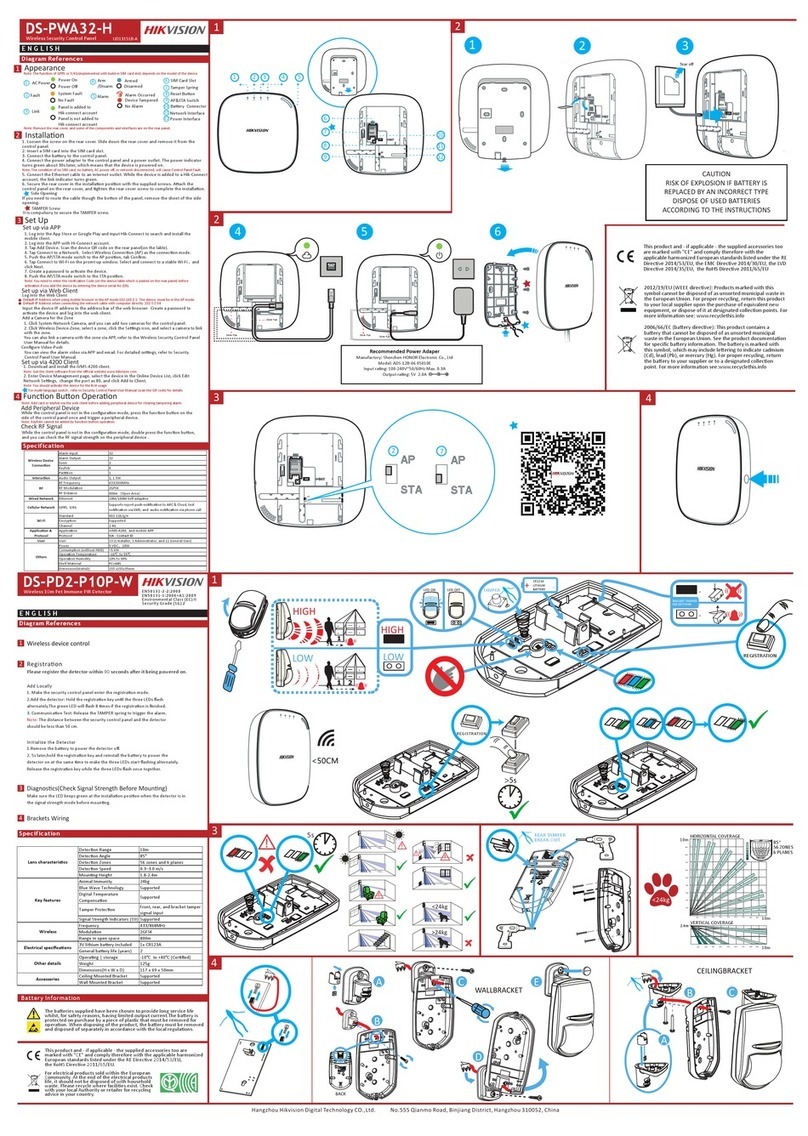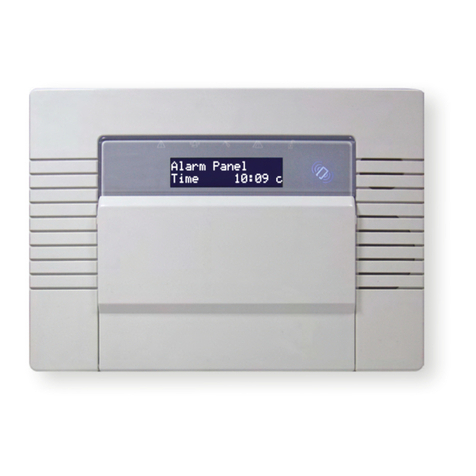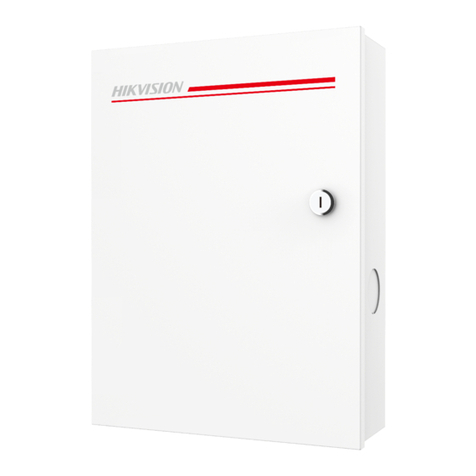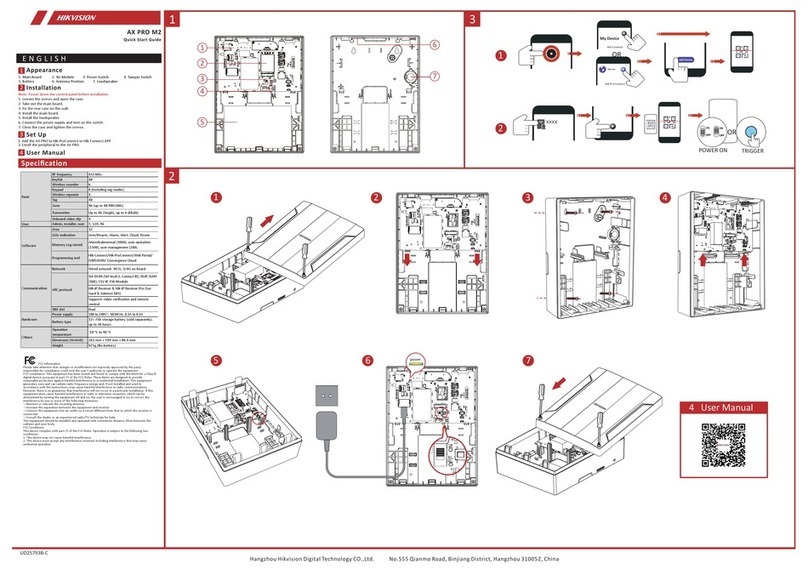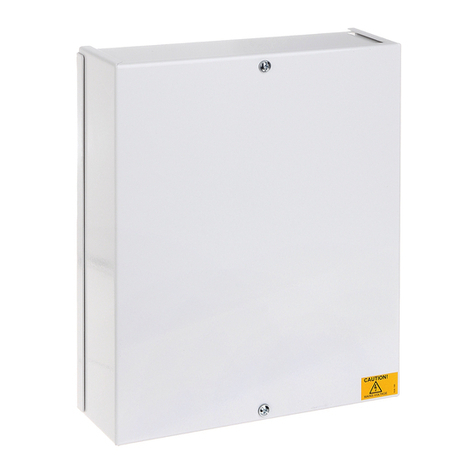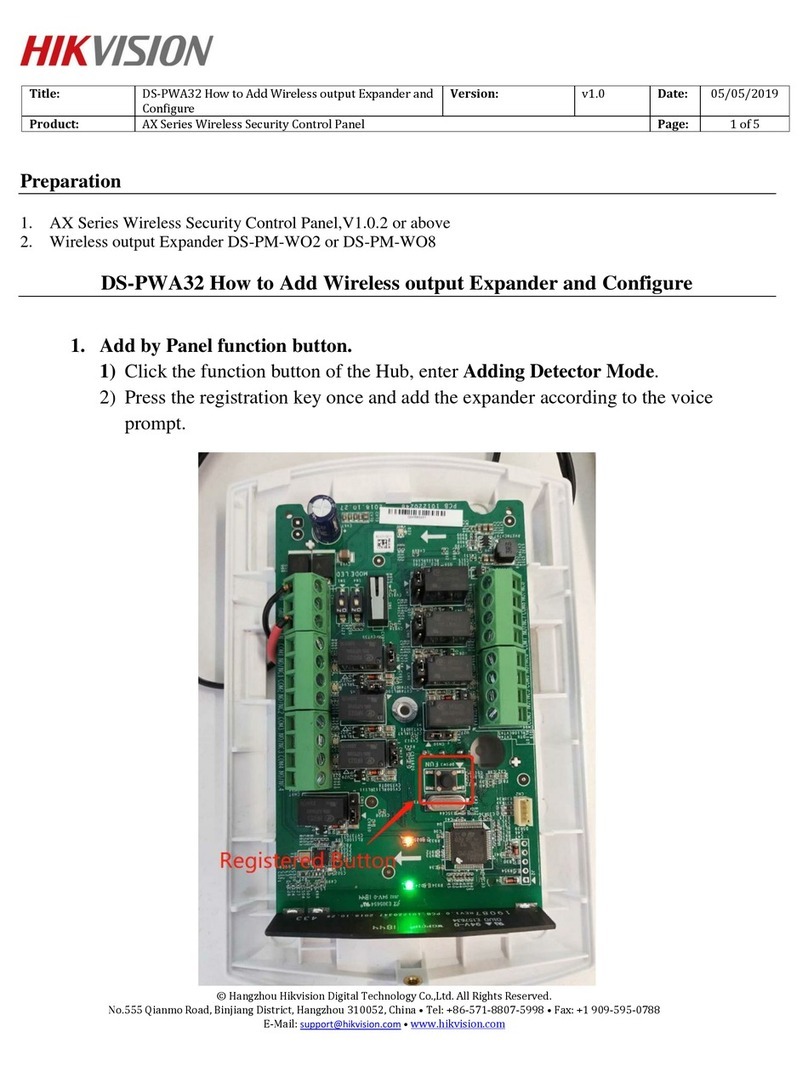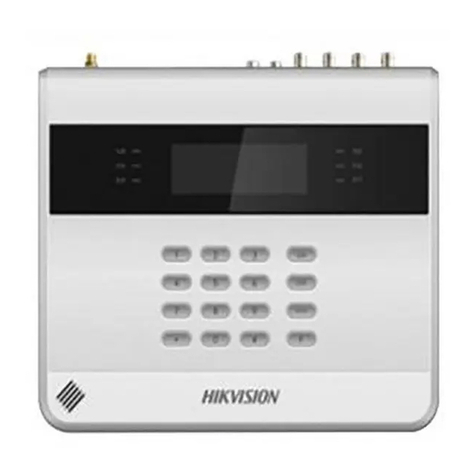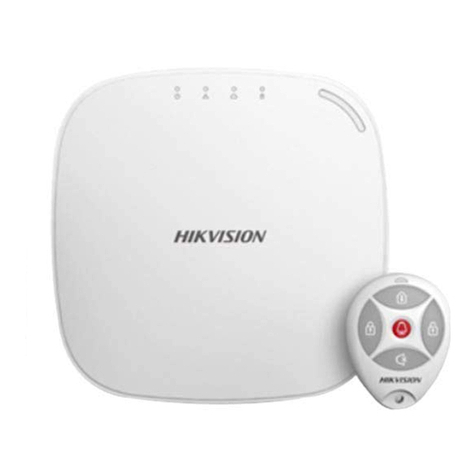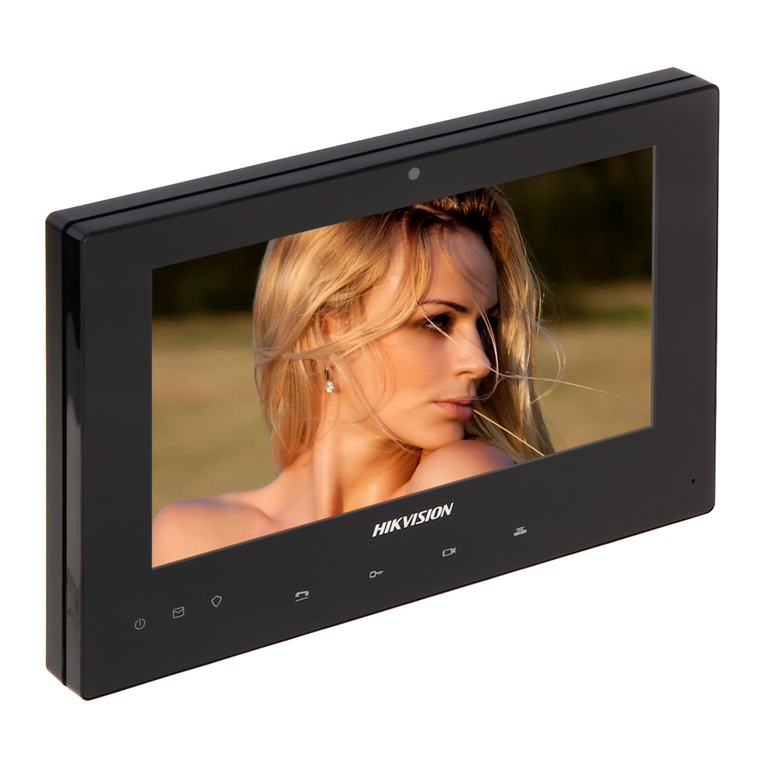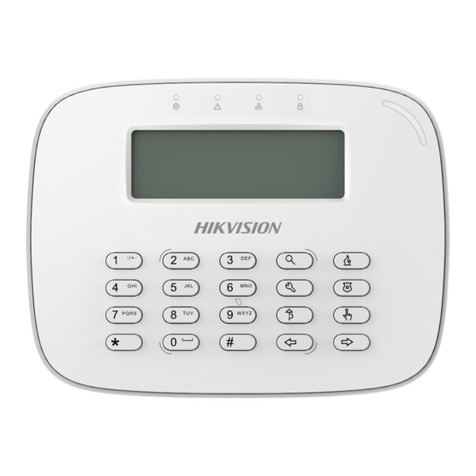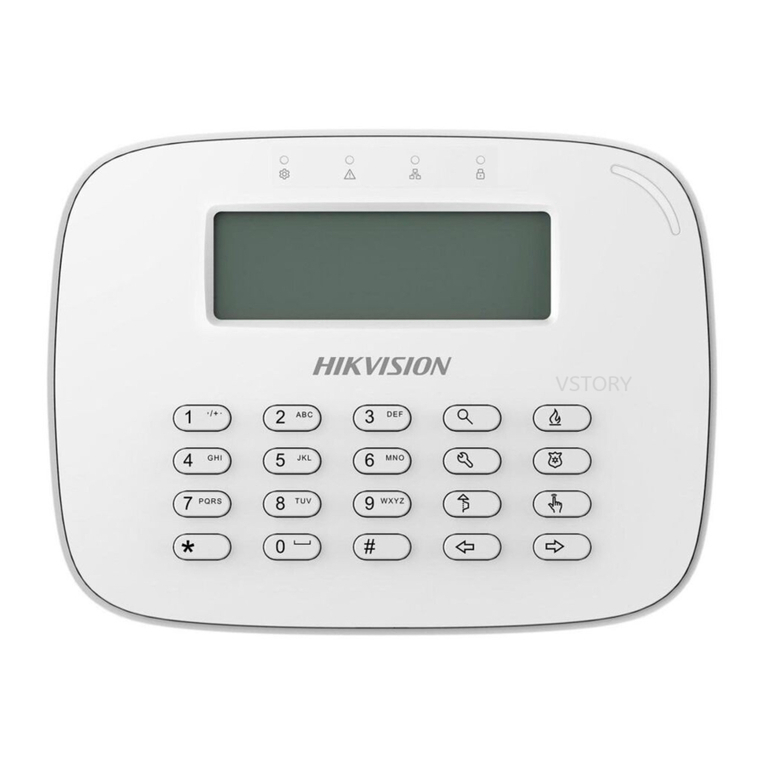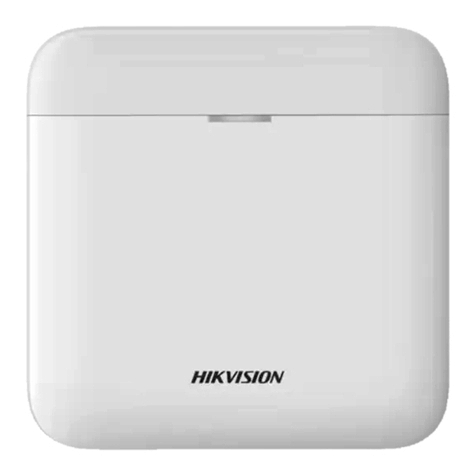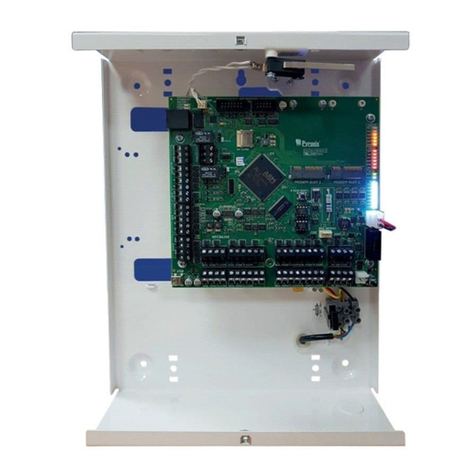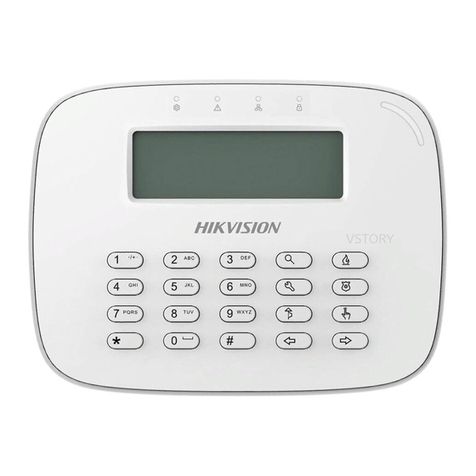
FRANÇAIS
Références du schéma
Apparence
Indicateurs
Allumer
Panne du système Aucune panne
Le panneau a été ajouté au compte Hik-Connect
Le panneau n’a pas été ajouté au compte Hik-Connect
Armé Désarmé
Alarme déclenchée Disposif saboté
Aucune alarme
Mise hors tension
Alimentaon
secteur
Panne
Liaison
Armer/Désarmer
Alarme
1
2
Composants
Remarque : rerez le capot arrière, car des composants et des interfaces sont situés sur le capot arrière.
Câblage et installaon
1. Desserrez les vis supérieures, appuyez sur le mécanisme de blocage, puis ouvrez le boîer du panneau
de commandes.
2. Faites passer les câbles, puis fixez le capot arrière dans sa posion d’installaon avec les vis fournies.
3. Fixez le module de la carte SIM (vendu séparément) avec quatre boulons en plasque.
4. Fixez le module téléphonique (vendu séparément) avec deux boulons en plasque.
5. Branchez les câbles.
1
2
2
2
3
5
4
Connecteur
de baerie
Interface
réseau
Port
d’alimenta-
on
Mécanisme
de blocage
Commutateur
AP/STA
Interrupteur
ANTI-
SABOTAGE
Borne de
câblage 2
12
2
13
2
11
Bouton de
réinialisaon
2
10
2
9
2
8
2
7
2
6
1
2
Câblage du module téléphonique
Entrée d’alarme/Sore d’alarme/Câblage RS-485
Câblage de l’entrée d’alarme
a. Détecteur de monoxyde de carbone (CO)
b. Détecteur de monoxyde d’azote (NO)
c. Zone inoccupée
d. Ansabotage
Câblage de la sore d’alarme
Câblage RS-485 : récepteur sans fil, clavier, etc.
Réseau
Alimentaon électrique
6. Connectez la baerie au panneau de commandes.
Remarque : lorsque le panneau de commandes est dépourvu de carte SIM, de baerie, n’est pas connecté à
alimentaon secteur ou au réseau, il connaît un dysfonconnement.
7. Fixez les câbles d’alimentaon à l’aide du clip d’aache.
8 Refermez le panneau de commandes sur le capot arrière, puis resserrez les vis supérieures pour
terminer l’installaon.
Vis SABOTAGE
Vous devez absolument fixer la vis SABOTAGE.
21
Configuraon
Configuraon avec le client Web
Connexion au client Web
Adresse IP par défaut lors de l’ulisaon d’un navigateur mobile en mode AP : 192.168.8.1. Le disposif doit être en
mode AP.
Adresse IP par défaut lors du raccordement du câble réseau directement avec un ordinateur : 192.0.0.64
Saisissez l’adresse IP du disposif dans la barre d’adresse du navigateur Web. Créez un mot de passe pour
acver le disposif et vous connecter au client Web.
Ajout d’une caméra pour la zone
La foncon varie selon le modèle de l’appareil.
1. Cliquez sur « Caméra réseau de système » et vous pourrez ajouter des caméras pour le panneau de
commandes.
2. Entrez sur la page « Geson des appareils », séleconnez une zone, puis séleconnez une caméra à
associer à cee zone.
Vous pouvez également associer une caméra à une zone via l’applicaon. Pour obtenir plus de
renseignements, veuillez vous référer au Manuel d’ulisaon du panneau de commandes de sécurité.
Configuraon de la noficaon push vidéo (Video-Push)
Vous pouvez visionner la vidéo de l’alarme via l’applicaon et l’e-mail. Pour une configuraon détaillée,
reportez-vous au manuel d’ulisaon du panneau de commandes de sécurité.
Configuraon via l’applicaon
1. Connectez-vous à la bouque d’applicaons « App Store » ou « Google Play » et saisissez « Hik-Connect
» pour rechercher et installer le client mobile.
2. Connectez-vous à l’applicaon avec votre compte Hik-Connect.
3. Touchez « Ajouter un disposif ». Scannez le code QR du disposif figurant sur l’équee collée sur le
panneau arrière.
4. Touchez « Connexion au réseau ». Séleconnez « Connexion sans fil (AP) » comme mode de connexion.
5. Placez le commutateur de mode AP/STA sur la posion AP et touchez « Confirmer ».
6. Touchez « Connexion Wi-Fi » dans la fenêtre qui s’affiche. Séleconnez un réseau Wi-Fi stable auquel
vous connecter et cliquez sur « Suivant ».
7. Créez un mot de passe pour acver le disposif.
8. Placez le commutateur de mode AP/STA sur la posion STA.
Remarque : vous devez saisir le code de vérificaon (figurant sur l’équee du disposif collée sur le panneau
arrière) avant l’acvaon si vous ajoutez le disposif en entrant son numéro de série (NS).
Configuraon avec le client iVMS-4200
1. Téléchargez et installez le client iVMS-4200.
Remarque : vous pouvez télécharger le logiciel client sur le site Web officiel : www.hikvision.com.
2. Accédez à la page « Geson des disposifs », séleconnez le disposif dans la liste des disposifs en
ligne ; cliquez sur « Modifier les paramètres réseau », modifiez le port à 80, puis cliquez sur « Ajouter
au client ».
Remarque : vous devez acver le disposif à la première ulisaon.
Rétablissement des paramètres par défaut
Redémarrer l’appareil. Démarrez l’appareil, puis appuyez sur le bouton de réinialisaon pendant 5 s
après que l’indicateur de défaut a clignoté 3 fois. L’appareil délivrera un message indiquant le statut de
l’opéraon.
3
Spécification
3
4
22
23
DS-PHA20-P
DS-PHA64-P
DS-PHA20-W2P
DS-PHA64-W4P
Détecteur sans fil
Extenseur de sore sans fil
Sirène
Porte-clés
Paron
Zone
Sore d’alarme Sore d’alarme
Armement/Désarmement
programmé
Noficaon de SMS
(avec module 3G/4G/GPRS)
Accès aux caméras réseau N/D 2 (DS-PHA20)
4 (DS-PHA64)
Applicaon
Protocole
Réseau filaire
Réseau cellulaire
(avec module 3G/4G/GPRS)
Standard N/D 802.11b/g/n
Cryptage N/D WPS, WPA-PSK/WPA2-PSK, WPA/WPA2, WEP
64/128 bits
N/D Mode point d’accès
N/D Intérieur : ≤ 50 m
Extérieur : ≤ 100 m
Interrupteur ANTI-SABOTAGE
Interface réseau
Interface téléphonique
Terminal RS-485
Interface d’alimentaon des
sirènes
Interface de la baerie
Ulisateur
Équetage
Température de fonconnement
Humidité de fonconnement
Dimensions (L x H x P)
Ulisateur
Modèle
Connexion des
appareils
Jusqu’à 16/56
Jusqu’à 8
1 sirène filaire (raccordement intégré)
2 sirènes sans fil
8, intervalle d’opéraon valide : 3 s
Panneau de commandes de sécurité hybride avec boîer en plasque
Entrée d’alarme
4 (DS-PHA20)
8 (DS-PHA64)
4 zones intégrées, pouvant s’étendre jusqu’à 16 zones filaires/sans fil (DS-PHA20),
ou
8 zones intégrées, pouvant s’étendre jusqu’à 56 zones filaires/sans fil (DS-PHA64)
2 sores intégrées, pouvant s’étendre jusqu’à 18 sores filaires/sans fil (DS-PHA20),
ou
4 sores intégrées, pouvant s’étendre jusqu’à 60 sores filaires/sans fil (DS-PHA64)
Foncon
Prend en charge jusqu’à 8 numéros de téléphone mobile
1, interface de l’extenseur PSTN
1, étendu jusqu’à 20 entrées/sores (avec le module RS-485),
et pouvant s’étendre jusqu’à 9 claviers filaires (DS-PHA20),
ou
1, étendu jusqu’à 64 entrées/sores (avec le module RS-485),
et pouvant s’étendre jusqu’à 9 claviers filaires (DS-PHA64)
1, 12 V
Baerie au lithium (modèle -P)
Applicaon et
protocole
iVMS-4200 (logiciel client)
Hik-Connect (client mobile)
ISAPI : prend en charge le logiciel client et le client Web
Cloud P2P : prend en charge le protocole P2P de protecon de la vie privée sur le cloud
DC09 : accessible à l’ARC (protocole CID/SIA)
Réseau
Ethernet 10 Mo/100 Mo
Prend en charge les noficaons de rapport vers l’ARC et le cloud
Installateur : 1
Administrateur : 1
Fabricant : 1
Opérateur : 13 (DS-PHA20), 45 (DS-PHA64)
Autres
De –10 °C à +55 °C (-4 °F à +122 °F)
De 10 % à 90 % (sans condensaon)
Boîer en plasque : 220 mm (8,6") x 152 mm (6,0") x 31,5 mm (1,2")
Wi-Fi
Interface et
composants
1, interrupteur an-sabotage sur le capot avant
1, interface Ethernet RJ45 10 Mo/100 Mo
Remarque : la sirène sans fil de 868 MHz peut être aribuée au panneau de commandes hybride via le récepteur sans fil
établi à l’adresse 9.
Configuraon
Distance
PORTUGUÊS
Referências do diagrama
Apresentação
Indicadores
Avação
Falha no sistema sem falhas
O painel foi adicionado à conta Hik-connect
O painel não foi adicionado à conta Hik-connect
armado desarmado
Um alarme ocorreu Disposivo violado
não há alarmes
Desavação
Alimentação de
CA
Falha
Conexão
Armar/desarmar
Alarme
1
2
Componentes
Observação: remova a tampa traseira. Alguns dos componentes e interfaces estão no painel traseiro.
Cabeamento e instalação
1. Solte o parafuso na parte superior, pressione a trava e abra a caixa do painel de controle.
2. Passe os cabos e prenda a tampa traseira na posição de instalação com os parafusos fornecidos.
3. Prenda o módulo de cartão SIM (deve ser adquirido separadamente) com quatro parafusos pláscos.
4. Prenda o módulo de telefone (deve ser adquirido separadamente) com dois parafusos pláscos.
5. Ligue os cabos.
1
2
2
2
3
5
4
Conector da
bateria
Interface
de rede
Entrada de
alimentação
Trava
Chave AP
e STA
Interruptor
de violação
Terminal
de fiação 2
12
2
13
2
11
Botão de
redefinição
2
10
2
9
2
8
2
7
2
6
1
2
Cabeamento do módulo de telefone
Cabeamento da entrada de alarme/saída de alarme/RS-485
Cabeamento da entrada de alarme
a. Detector NF
b. Detector NA
c. Zona desocupada
d. Anviolação
Cabeamento da saída de alarme
Cabeamento RS-485: receptor sem fio, teclado, etc.
Rede
Fonte de alimentação
6. Conecte a bateria ao painel de controle.
Observação: as condições de ausência de cartão SIM, ausência de bateria, alimentação de CA desligada ou rede
desconectada causarão falha no painel de controle.
7. Prenda os cabos de alimentação com o fixador de cabos.
8 Prenda o painel de controle na tampa traseira e aperte os parafusos superiores para concluir a
instalação.
Parafuso anviolação
É obrigatório apertar o parafuso anviolação.
21
Configuração
Configurar via cliente Web
Acessar o cliente Web
Endereço IP padrão ao usar um navegador para celular em modo AP: 192.168.8.1. O disposivo deve estar em modo AP.
Endereço IP padrão ao conectar o cabo de rede diretamente ao computador: 192.0.0.64
Insira o endereço IP do disposivo na barra de endereços do navegador da internet. Crie uma senha para
avar o disposivo e acesse o cliente Web.
Adicionar uma câmera para a zona
Essa função varia dependendo no modelo do disposivo.
1. Para adicionar câmeras ao painel de controle, clique em Sistema - Câmera de Rede.
2. Entre na página Gerenciamento de Disposivos, selecione uma zona e escolha uma câmera para
vincular a ela.
É possível vincular uma câmera a uma zona pelo app. Para ver os detalhes, consulte o Manual do Usuário
do Painel de Controle de Segurança.
Configurar o envio de vídeos
Você pode visualizar o vídeo do alarme através do app e via e-mail. Para configurações detalhadas,
consulte o Manual do Usuário do Painel de Controle de Segurança.
Configurar via app
1. Acesse a App Store ou o Google Play e digite Hik-Connect para buscar e instalar o cliente móvel.
2. Acesse o app com a conta Hik-Connect.
3. Toque em Adicionar Disposivo. Leia o código QR no painel traseiro (na equeta).
4. Toque em Conectar a uma Rede. Selecione Conexão Sem Fio (AP) como modo de conexão.
5. Coloque a chave dos modos AP/STA na posição AP e toque em Confirmar.
6. Toque em Conectar ao Wi-Fi na janela de aviso. Selecione e conecte-se a uma rede Wi-Fi estável e
clique em Avançar.
7. Crie uma senha para avar o disposivo.
8. Coloque a chave dos modos AP/STA na posição STA.
Observação: ao adicionar o disposivo usando o número de série (NS), é necessário inserir o código de verificação
(na equeta do disposivo colada no painel traseiro) antes da avação.
Configurar via cliente 4200
1. Baixe e instale o cliente iVMS-4200.
Observação: obtenha o soware cliente no site oficial: www.hikvision.com.
2. Entre na página Gerenciamento de Disposivos, selecione o disposivo na Lista de Disposivos On-line,
clique em Editar Configurações de Rede, altere a porta para 80 e clique em Adicionar ao Cliente.
Observação: ao usar o disposivo pela primeira vez, é necessário avá-lo.
Restaurar as configurações padrão
Reinicie o disposivo. Inicialize o disposivo e segure o botão de redefinição por 5 s após o indicador de
falha piscar 3 vezes. O disposivo mostrará uma mensagem para indicar o status da operação.
3
Especificações
3
4
22
23
DS-PHA20-P
DS-PHA64-P
DS-PHA20-W2P
DS-PHA64-W4P
Detector sem fio
Expansor de saídas sem fio
Sirene
Controle remoto
Parção
Zona
Saída de alarme Saída de alarme
Armação/desarme programados
Noficação por SMS
(com módulo 3G/4G/GPRS)
Acesso a câmeras de rede Não disponível 2 (DS-PHA20)
4 (DS-PHA64)
Aplicavo
Protocolo
Rede com fio
Rede celular
(com módulo 3G/4G/GPRS)
Padrão Não disponível 802.11b/g/n
Criptografia Não disponível WEP de 64/128 bits, WPA/WPA2,
WPA-PSK/WPA2-PSK, WPS
Não disponível Modo AP
Não disponível Interior: ≤ 50 m
Exterior: ≤ 100 m
Interruptor de violação
Interface de rede
Interface de telefone
Terminal RS-485
Interface de alimentação de sirene
Interface de bateria
Usuário
Idenficador
Temperatura de operação
Umidade de operação
Dimensões (L × A × P)
Usuário
Modelo
Conexão de
disposivos
Até 16/56
Até 8
1 sirene com fio (conexão integrada)
2 sirenes sem fio
8, intervalo de operação válido: 3 s
Painel de controle de segurança híbrido com caixa de plásco
Entrada de
alarme
4 (DS-PHA20)
8 (DS-PHA64)
4 zonas integradas e 16 zonas expansíveis com/sem fio (DS-PHA20),
ou
8 zonas integradas e 56 zonas expansíveis com/sem fio (DS-PHA64)
2 saídas integradas e 18 saídas expansíveis com/sem fio (DS-PHA20),
ou
4 saídas integradas e 60 saídas expansíveis com/sem fio (DS-PHA64)
Função
Suporta até 8 números de celular
1 interface de expansão PSTN
1, expandido para até 20 entradas/saídas (com módulo RS-485) e expansível
para 9 teclados com fio (DS-PHA20),
ou
1, expandido para até 64 entradas/saídas (com módulo RS-485) e expansível
para 9 teclados com fio (DS-PHA64)
1 de 12 V
Bateria de lío (modelo -P)
Aplicavo e
protocolo
iVMS-4200 (soware cliente)
Hik-Connect (cliente móvel)
ISAPI: suporta soware cliente e cliente Web
Nuvem P2P: suporta protocolo de privacidade em nuvem P2P
DC09: acessível por ARC (CID/SIA)
Rede
Ethernet 10/100
Suporta o envio de noficações push para ARC e nuvem
Instalador: 1
Administrador: 1
Fabricante: 1
Operador: 13 (DS-PHA20), 45 (DS-PHA64)
Outros
–10 °C a 55 °C (-4 °F a 122 °F)
10% a 90% (sem condensação)
Caixa de plásco: 220 mm (8,6") × 152 mm (6,0") × 31,5 mm (1,2")
Wi-Fi
Interfaces e
componentes
1 tampa frontal à prova de violação
1 interface Ethernet RJ45 10/100
Observação: a sirene sem fio de 868 MHz pode ser registrada no painel de controle híbrido via o receptor sem fio que está
no endereço 9.
Configuração
Distância
ITALIANO
Riferimento schemi
Aspeo
Indicatori
Accensione
Guasto di sistema nessun guasto
Pannello aggiunto all'account Hik-connect
Pannello non aggiunto all'account Hik-connect
Inserito Disinserito
Occorrenza di allarme Manomissione disposivo
Nessun allarme
Spegnimento
Alimentazione
CA
Errore
Collegamento
Inserimento/
Disinserimento
Allarme
1
2
Componen
Nota: Rimuovere il coperchio posteriore, poiché alcuni componen e interfacce si trovano nel pannello posteriore.
Cablaggio e installazione
1. Allentare la vite sulla parte superiore, premere il controdado e aprire l'involucro del pannello di
controllo.
2. Posare i cavi e fissare il coperchio posteriore nella posizione di installazione con le vi in dotazione.
3. Fissare il modulo della scheda SIM (venduto separatamente) con quaro bulloni in plasca.
4. Installare il modulo telefonico (venduto separatamente) con due bulloni in plasca.
5. Posare i cavi.
1
2
2
2
3
5
4
Conneore
della baeria
Interfaccia
di rete
Interfaccia di
alimentazione
Controdado
Seleore
AP/STA
Interruore
ANTIMANOMISSIONE
Terminale
di cablaggio 2
12
2
13
2
11
Pulsante di
reset
2
10
2
9
2
8
2
7
2
6
1
2
Cablaggio modulo telefonico
Ingresso/uscita allarme/Cablaggio RS-485
Cablaggio ingresso allarme
a. Rilevatore NC
b. Rilevatore NA
c. Zona non occupata
d. An-manomissione
Cablaggio uscita di allarme
Cablaggio RS-485: Taserino, ricevitore, ecc. wireless
Rete
Alimentazione
6. Collegare la baeria al pannello di controllo.
Nota: L’assenza di scheda SIM, l’assenza di baeria, l’interruzione dell’alimentazione CA o la disconnessione di rete
causano un errore del pannello di controllo.
7. Fissare i cavi di alimentazione con il fermacavo.
8 Chiudere il coperchio posteriore del panello di controllo e stringere le vi superiori per completare
l’installazione.
Vite ANTIMANOMISSIONE
È obbligatorio fissare la vite ANTIMANOMISSIONE.
21
Impostazione
Impostazione tramite client web
Accedere al client web
Indirizzo IP predefinito quando si ulizza il browser per disposivi mobili in modalità AP: 192.168.8.1. Il disposivo
deve essere in modalità AP.
Indirizzo IP predefinito quando il cavo di rete viene collegato direamente al computer: 192.0.0.64
Inserire l'indirizzo IP del disposivo nella barra degli indirizzi del browser web. Creare una password per
avare il disposivo e accedere al client web.
Aggiungere una telecamera per la zona
La funzione varia a seconda del modello del disposivo.
1. Fare clic su Sistema-Telecamera di rete per aggiungere telecamere al pannello di controllo.
2. Accedere alla pagina “Gesone disposivo”, selezionare una zona, quindi selezionare una telecamera
da abbinare alla zona.
È anche possibile abbinare una telecamera alla zona tramite app; per ulteriori deagli, consultare il
manuale d'uso del pannello di controllo sicurezza .
Configurazione video push
È possibile visualizzare i video di allarme tramite APP ed e-mail. Per i deagli delle impostazioni,
consultare il manuale d'uso del pannello di controllo.
Impostazione tramite APP
1. Accedere ad App Store o Google Play e inserire Hik-Connect per cercare e installare il client mobile.
2. Accedere all'app con l'account Hik-Connect.
3. Toccare Aggiungi disposivo. Effeuare la scansione del codice QR situato sul pannello posteriore del
disposivo (sull'echea).
4. Toccare Conne alla rete. Selezionare Connessione wireless (AP) come modalità di connessione.
5. Spostare il seleore di modalità AP/STA in posizione AP e toccare Conferma.
6. Toccare Conne a Wi-Fi sulla finestra di richiesta a comparsa. Selezionare una rete Wi-Fi stabile e
conneersi ad essa, poi fare clic su Avan.
7. Creare una password per avare il disposivo.
8. Spostare il seleore di modalità AP/STA in posizione STA.
Nota: In caso di aggiunta del disposivo tramite inserimento del numero di serie (SN), occorre immeere il codice di
verifica (disponibile sull'echea del disposivo applicata al pannello posteriore) prima dell'avazione.
Impostazione tramite Client 4200
1. Scaricare e installare il client iVMS-4200.
Nota: Scaricare il soware client dal sito web ufficiale: www.hikvision.com.
2. Accedere alla pagina di Gesone dei disposivi, selezionare il disposivo dall'elenco di disposivi online, fare
clic su Modifica impostazioni di rete, inserire il numero di porta 80 e fare clic su Aggiungi al client.
Nota: Il disposivo deve essere avato per il primo ulizzo.
Riprisno delle impostazioni predefinite
Riavviare il disposivo. Riavviare il disposivo e tenere premuto il pulsante di reset per 5 secondi dopo
che l'indicatore di guasto lampeggia 3 volte. Il disposivo mostrerà un messaggio per indicare lo stato di
funzionamento.
3
Specifiche
3
4
22
23
DS-PHA20-P
DS-PHA64-P
DS-PHA20-W2P
DS-PHA64-W4P
Rilevatore wireless
Espansore di uscite wireless
Sirena
Portachiavi
Parzione
Zona
Uscita allarme Uscita allarme
Inserimento/Disinserimento
programmato
Nofica SMS
(con modulo 3G/4G/GPRS)
Accesso telecamera di rete N/D 2 (DS-PHA20)
4 (DS-PHA64)
Applicazione
Protocollo
Rete cablata
Rete cellulare
(con modulo 3G/4G/GPRS)
Standard N/D 802.11b/g/n
Criografia N/D 64/128-bit
WEP,WPA/WPA2,WPA-PSK/WPA2-PSK,WPS
N/D Modalità AP
N/D Interno: ≤ 50 m
Esterni: ≤ 100 m
Interruore ANTIMANOMISSIONE
Interfaccia di rete
Interfaccia telefono
Terminale RS-485
Interfaccia di alimentazione sirena
Interfaccia baeria
Utente
Tag
Temperatura di funzionamento
Umidità di funzionamento
Dimensioni (L × A × P)
Utente
Modello
Connessione del
disposivo
Fino a 16/56
Fino a 8
1 sirena cablata (connessione su scheda)
2 sirene wireless
8, intervallo operavo valido: 3 s
Pannello di controllo sicurezza ibrido con involucro in plasca
Ingresso di
allarme
4 (DS-PHA20)
8 (DS-PHA64)
4 zone su scheda e 16 zone cablate/wireless espansibili (DS-PHA20)
oppure
8 zone su scheda e 56 zone cablate/wireless espansibili (DS-PHA64)
2 uscite su scheda e 18 uscite cablate/wireless espansibili (DS-PHA20)
oppure
4 uscite su scheda e 60 uscite cablate/wireless espansibili (DS-PHA64)
Funzione
Supporta fino a 8 numeri telefonici mobili
1, Interfaccia espansore PSTN
1, esteso fino 20 ingressi/uscite (con modulo RS-485)
e 9 taserini cabla estensibili (DS-PHA20),
oppure
1, esteso fino 64 ingressi/uscite (con modulo RS-485)
e 9 taserini cabla estensibili (DS-PHA64)
1, 12 V
Baeria al lio (modello -P)
Applicazione e
protocollo
iVMS-4200 (soware client)
Hik-Connect (client mobile)
ISAPI: supporta client soware e client Web
Cloud P2P: supporta il protocollo privato cloud P2P
DC09: ARC accessibile (CID/SIA)
Rete
10M/100M Ethernet
Supporta nofiche push di report a ARC e cloud
Installatore: 1
Amministratore: 1
Produore:1
Operatore: 13 (DS-PHA20), 45 (DS-PHA64)
Altro
da -10 °C a 55 °C
da 10% a 90% (senza condensa)
Involucro in plasca: 220 mm × 152 mm × 31,5 mm
Wi-Fi
Interfaccia e
componen
1, coperchio anteriore an-manomissione
1 Interfaccia Ethernet RJ45 10M/100M
Nota: la sirena wireless a 868 Mhz può essere registrata nel pannello di controllo ibrido tramite il ricevitore wireless
localizzato all’indirizzo 9.
Configurazione
Distanza
ESPAÑOL
Referencias del diagrama
Apariencia
Indicadores
Encendido
fallo del sistema Sin error
Panel agregado a la cuenta Hik-Connect
Panel no agregado a la cuenta Hik-Connect
armado desarmado
Se acvó una alarma Disposivo manipulado
ninguna alarma
Apagar
Alimentación CA
Fallo
Conexión
Armar/desarmar
Alarma
1
2
Componentes
Nota: rere la tapa trasera para acceder a algunos de los componentes y conexiones del panel trasero.
Cableado e instalación
1. Afloje el tornillo de la parte superior, presione la contratuerca y abra la caja del panel de control.
2. Pase los cables y fije la tapa trasera en la posición de instalación con los tornillos suministrados.
3. Fije el módulo de la tarjeta SIM (debe comprarse por separado) con cuatro tornillos de plásco.
4. Fije el módulo del teléfono (debe comprarse por separado) con dos tornillos de plásco.
5. Conecte los cables.
1
2
2
2
3
5
4
Conector de
la batería
Conexión
de red
Conexión de
alimentación
Contratuerca
Interruptor de
«Punto de acceso»/
«Estación de trabajo»
interruptor
anmanipulación
Terminal de
cableado 2
12
2
13
2
11
Botón
Reiniciar
2
10
2
9
2
8
2
7
2
6
1
2
Cableado del módulo telefónico
Entrada de alarma/salida de alarma/cableado RS-485
Cableado de entrada de alarma
a. Detector NC
b. Sin detector
c. Zona desocupada
d. Anmanipulación
Cableado de salida de alarma
Cableado RS-485: Receptor inalámbrico, teclado, etc.
Red
Alimentación eléctrica
6. Conecte la batería al panel de control.
Nota: los siguientes estados provocarán un fallo en el panel de control: sin tarjeta SIM, sin batería, sin corriente o
red desconectada.
7. Fije los cables de alimentación con el clip para los cables.
8 Cierre la tapa trasera del panel de control y apriete los tornillos superiores para completar la
instalación.
Tornillo anmanipulación
Es obligatorio asegurar el tornillo anmanipulación.
21
Configuración
Configurar a través del cliente web
Inicie sesión en el cliente web
Dirección IP predeterminada al ulizar el navegador móvil en modo de punto de acceso: 192.168.8.1. El disposivo
debe estar en modo de punto de acceso.
Dirección IP predeterminada al conectar el cable de red directamente al ordenador: 192.0.0.64
Introduzca la dirección IP del disposivo en la barra de direcciones del navegador web. Cree una
contraseña para acvar el disposivo e inicie sesión en el cliente web.
Añadir una cámara para la zona
La función varía según el modelo de disposivo.
1. Haga clic en Cámara de red de sistema y podrá añadir cámaras al panel de control.
2. Acceda a la página de administración de disposivos, seleccione una zona y seleccione una cámara para
vincularla a esa zona.
También puede vincular una cámara a la zona a través de la aplicación. Consulte el Manual de usuario del
panel de control de seguridad para más información.
Configure las noficaciones de vídeo
Puede ver el vídeo de alarma a través de la aplicación y el correo electrónico. Para ver los detalles de la
configuración, consulte el Manual de usuario del panel de control de seguridad.
Configurar a través de la aplicación
1. Acceda a App Store o a Google Play e introduzca Hik-Connect para buscar e instalar el cliente móvil.
2. Inicie sesión en la aplicación con la cuenta de Hik-Connect.
3. Pulse Añadir disposivo. Escanee el código QR del panel trasero (en la equeta).
4. Pulse Conectar a una red. Seleccione Conexión inalámbrica (PA) como modo de conexión.
5. Sitúe el interruptor de modo «Punto de acceso»/«Estación de trabajo» en posición de punto de acceso,
pulse Confirmar.
6. Pulse Conectar a wifi en la ventana emergente. Seleccione y conéctese a una red wifi estable y haga clic
en Siguiente.
7. Cree una contraseña para acvar el disposivo.
8. Sitúe el interruptor de modo «Punto de acceso/Estación de trabajo» en la posición de estación de
trabajo.
Nota: debe introducir el código de verificación (situado en la equeta del disposivo pegada en el panel trasero)
antes de la acvación si añade el disposivo introduciendo el número de serie (SN).
Configuración a través del cliente 4200
1. Descargue e instale el cliente iVMS-4200.
Nota: obtenga el soware de cliente en la página web oficial: www.hikvision.com.
2. Acceda a la página de administración de disposivos, seleccione el disposivo en la lista de disposivos
en línea, haga clic en Editar ajustes de red, cambie el puerto a 80 y haga clic en Añadir a cliente.
Nota: debe acvar el disposivo para su primer uso.
Restaurar la configuración predeterminada
Reiniciar disposivo. Encienda el disposivo y mantenga pulsado el botón de reinicio durante 5 s después
de que el indicador de fallos parpadee 3 veces. El disposivo mostrará un mensaje que indica el estado
operavo.
3
Especificaciones
3
4
22
23
DS-PHA20-P
DS-PHA64-P
DS-PHA20-W2P
DS-PHA64-W4P
Detector inalámbrico
Expansor de salida inalámbrico
Sirena
Llavero transmisor
Parción
Zona
Salida de alarma Salida de alarma
Armado/desarmado programado
Noficación SMS
(con módulo 3G/4G/GPRS)
Acceso a cámara de red N/D 2 (DS-PHA20)
4 (DS-PHA64)
Aplicación
Protocolo
Red por cable
Red móvil
(con módulo 3G/4G/GPRS)
Estándar N/D 802.11b/g/n
Cifrado N/D WEP de 64/128 bits,
WPA/WPA2,WPA-PSK/WPA2-PSK,WPS
N/D Modo de punto de acceso
N/D Interior: ≤ 50 m
Exterior: ≤ 100 m
interruptor anmanipulación
Conexión de red
Interfaz telefónica
Terminal RS-485
Interfaz de alimentación de la
sirena
Interfaz de batería
Usuario
Equeta
Temperatura de funcionamiento
Humedad de funcionamiento
Dimensiones (ancho × alto × largo)
Usuario
Modelo
Conexión del
disposivo
Hasta 16/56
Hasta 8
1 sirena con cable (conexión incorporada)
Dos sirenas inalámbricas
8, intervalo operavo válido: 3 s
Panel de control de seguridad híbrido con caja de plásco
Entrada de
alarma
4 (DS-PHA20)
8 (DS-PHA64)
4 zonas incorporadas y ampliable a 16 zonas con cable/inalámbricas (DS-PHA20)
o
8 zonas incorporadas y ampliable a 56 zonas con cable/inalámbricas (DS-PHA64)
2 salidas incorporadas y ampliable a 18 salidas con cable/inalámbricas (DS-PHA20)
o
4 salidas incorporadas y ampliable a 60 salidas con cable/inalámbricas (DS-PHA64)
Función
Compable con hasta 8 números de teléfono móvil
1, interfaz de expansión PSTN
1, ampliado a 20 entradas/salidas (con módulo RS-485) y ampliable a 9 teclados con
cable (DS-PHA20)
o
1, ampliado a 64 entradas/salidas (con módulo RS-485) y ampliable a 9 teclados con
cable (DS-PHA64)
1, 12 V
Batería de lio (modelo -P)
Aplicación y
protocolo
iVMS-4200 (soware de cliente)
Hik-Connect (cliente móvil)
ISAPI: compable con el soware de cliente y el cliente web
Nube P2P: compable con el protocolo de privacidad P2P
DC09: accesible a CRA (CID/SIA)
Red
Ethernet 10 M/100 M
Compable con informes de noficación automazados a la central receptora de
alarmas (CRA) y a la nube
Instalador: 1
Administrador: 1
Fabricante: 1
Operador: 13 (DS-PHA20), 45 (DS-PHA64)
Otros
–10 °C a 55 °C (-4 °F a +122 °F)
10 % a 90 % (sin condensación)
Caja de plásco: 220 mm (8,6") × 152 mm (6,0") × 31,5 mm (1,2")
Wifi
Interfaces y
componentes
1, tapa delantera anmanipulación
1, interfaz Ethernet RJ45 10 M/100 M
Nota: la sirena inalámbrica de 868 MHz se puede registrar en el panel de control híbrido a través del receptor inalámbrico
que se encuentra en la dirección del 9.
Configuración
Distancia
